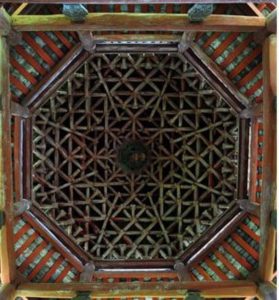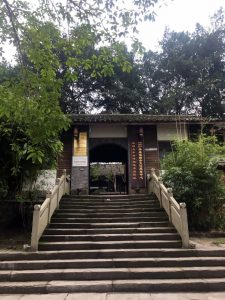LiZhuang 李庄 is an ancient village with over 1000 years of history and the birthplace of Yan from Inkston. LiZhuang played an extremely important role in the first half of the 20th century, however, due to political reasons, the village was ‘hidden’ from Chinese history till early 21st century. Because of such reasons, the village seemed to be isolated from modern world when Chinese economy had been booming for decades. During wartime, these temples were used as libraries, laboratories, or classrooms. Later between 1949 and 1992, they were either used as government office or warehouses. 
LiZhuang is located by Yantze river 长江. Traditionally, the Bo people 僰人 minority group (famous for their hanging coffins) lived here until virtually eliminated by the Ming Dynasty army. The village seems to be a museum of traditional Chinese architecture. There are over 40 temples which were built between Ming and Qing Dynasties and all had been preserved very well till Cultural Revolution. Therefore, the village is so important in traditional Chinese architecture history and had attracted quite a few great architects. The History of Chinese Architecture was written by famous architects Liang SiCheng 梁思成 and Lin HuiYin 林徽因 during their time in LiZhuang. In this book, they referred to quite a few ancient buildings in LiZhuang. For example, Luo Xuan Dian螺旋殿, which was built in 1596, was a completely wood-structured temple. It is a perfect example of traditional Chinese building structures. In 1940s, it was used as anatomy laboratory of TongJi University’s Medicine School.
In 1940s, when Japan was invading China, top Chinese universities had no place to move to. At this moment, this village made a great decision to invite these universities to come. The village mailed out the message which said: LiZhuang welcomes Tongji University to come and will provide all the facilities you need. (“同济迁川,李庄欢迎;一切需要,地方供给”). Suddenly this village of 3,000 population attracted over 12,000 scholars and students from Tongji University and top research institutes in China. During 1940s, quite a few academic achievements were made in LiZhuang.
 In order to help universities continue with daily teaching and researching activities, the village converted its ancient temples into classrooms, libraries, and laboratories. LuXuan Dian which was mentioned before was used as anatomy laboratory by Tongji University. Overnight, the ancient temples which had been used to host gods started to host modern science. It seems no one disagreed with this change. I am always very much surprised by this harmonious change of temples’ functions in this village. During this time, many foreign scholars were working in LiZhuang and some of them died and were buried in this village forever. The famous British biologist Joseph Needham was teaching and researching here in 1940s.
In order to help universities continue with daily teaching and researching activities, the village converted its ancient temples into classrooms, libraries, and laboratories. LuXuan Dian which was mentioned before was used as anatomy laboratory by Tongji University. Overnight, the ancient temples which had been used to host gods started to host modern science. It seems no one disagreed with this change. I am always very much surprised by this harmonious change of temples’ functions in this village. During this time, many foreign scholars were working in LiZhuang and some of them died and were buried in this village forever. The famous British biologist Joseph Needham was teaching and researching here in 1940s.
Later as Japan deployed more resources to invade China, Japanese started to ‘check on’ valuable Chinese antiques which were mostly collected by Qing Dynasty Royal Family in the Forbidden City. In order to protect these precious Chinese antiques, Chinese central government secretly moved them as fast as possible out of Beijing by rail to hide them in South-west China where Japan had not yet penetrated. Soon, Li Zhuang was one of these few secret places which were chosen by government and scholars to hide these treasures. Overnight, a large number of trains were filled with precious antiques and sent to LiZhuang. This is why nowadays, if you go to visit LiZhuang, you can still see one place was named as National Central Museum. It is said that later, some of these antiques were sent to Taiwan.
In the recent ten years, this village started to ‘appear’ in Chinese official history. It is still quiet and calm but soon it will attract many tourists. I hope tourism will not disturb the calm and beauty. I also hope more and more people will know what was happening here in the 20th century.
Traditional Chinese architecture uses a lot of patterns. Owen Jones once edited the book Examples of Chinese Ornament. This book collected beautiful traditional Chinese patterns. Inkston also have traditional handmade art materials which resembles these traditional beauty.
If you want to paint these beautiful ancient Chinese buildings, we recommend you to try inkston Gongbi Xuan papers because these papers will help paint details of the building.
No comments:
Post a Comment